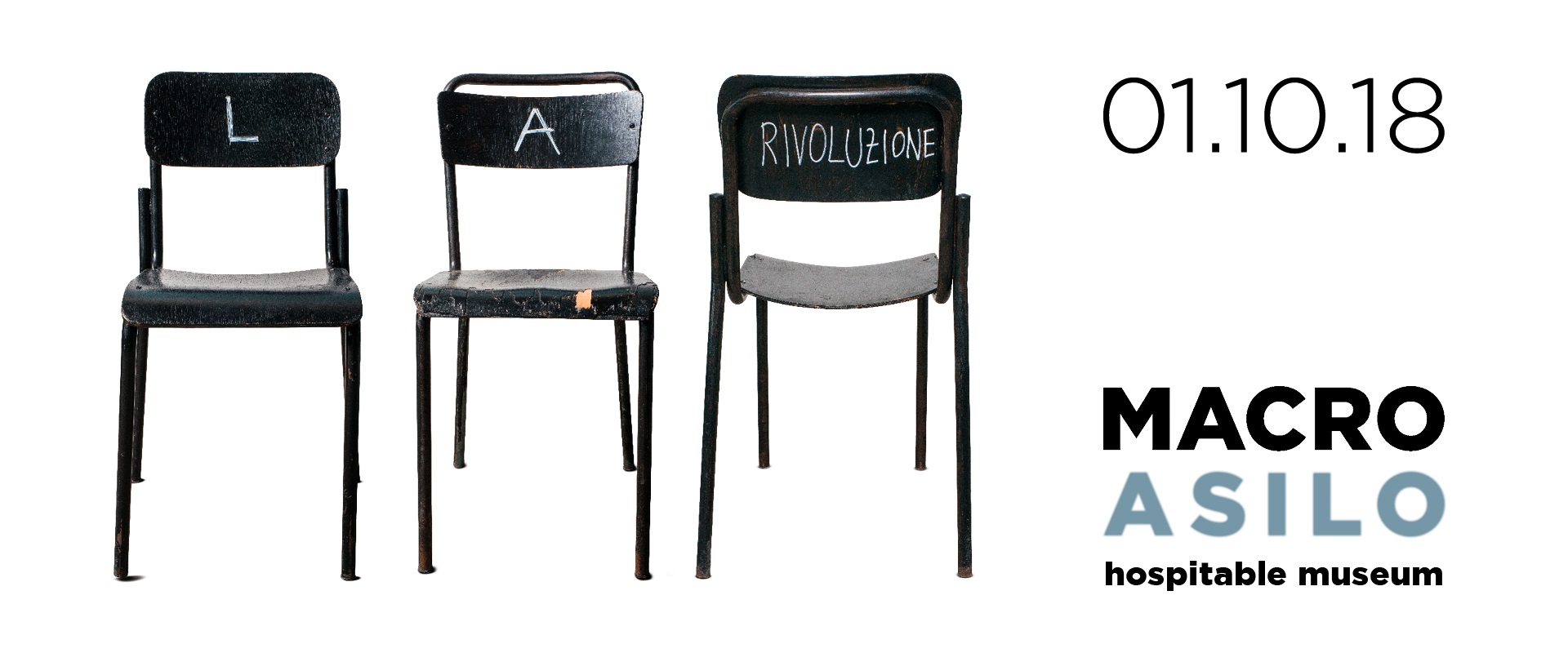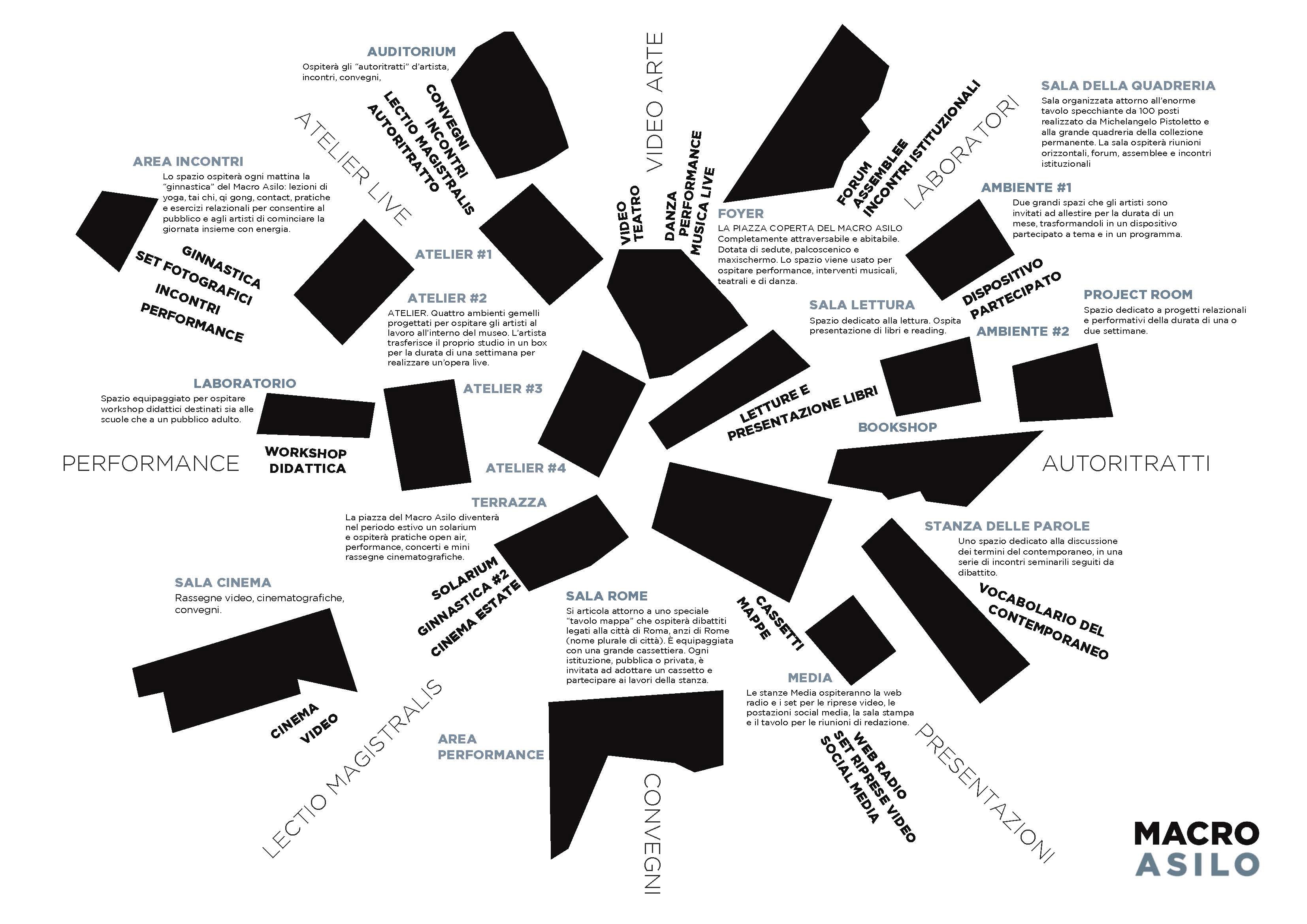
A party opened to all comers on 30 September started the experimental project known as
Macro Asilo, due to feature at the Macro in Via Nizza for 15 months, until 31 December 2019. The new scheme devised by project curator
Giorgio de Finis is going to turn the entire
museum into a fully-fledged
living organism at once "hospitable" and relational, urging people, skills and disciplines to meet and cooperate in a rationale of constant openness and participation on the part of the city and of the public. To ensure that that happens, admission will be free for everyone.
In this project the very idea of the
museum seeks to renew itself with the intention of forging a new and prolific relationship between art and the city. The experiment, in that sense, concerns precisely the city's museum of contemporary art, exploring its civic function as an institution operating in the present on the production of skills, sense and knowledge, an institution that uses art to place itself at people's disposal. Macro Asilo is the first piece in the
Contemporary and Future Cluster set to become a complementary presence compared to other institutions such as the MAXXI or the Galleria Nazionale, so as to offer the city's residents a rich spectrum of viewpoints and experiences.
That is the challenge from which de Finis took his cue, working in close cooperation with the Azienda Speciale Palaexpo which has been managing the museum since 1 January 2018, and with the Sovrintendenza Capitolina which, in its capacity as part of Roma Capitale, maintains responsibility for the conservation and enhancement of the museum's collection, archive and library.
According to
Luca Bergamo, Rome's Deputy Mayor and Councillor for Cultural Growth:
“Macro Asilo is part and parcel of a comprehensive strategy designed to rethink the role of the capital's cultural institutions and of their relationship not just with their focus communities but with the city as a whole. On the one hand, with the recent launch of the MIC, a new card offering free admission to civic museums, a decisive thrust has been imparted to boosting people's participation in Rome's cultural life and their opportunity to discover and enjoy its history and heritage. On the other, with Macro Asilo our specific aim is to change not just the way the public uses and enjoys a museum but the way it relates to it, by calling into question the ways in which that relationship has consolidated over time".
“Works of art as finished products and exhibitions as collections of those works are only one of the possible ways of transmitting knowlege and culture. The new opportunity offered by Macro Asilo is to transcend such a predefined modality of use and enjoyment by entering into an ongoing relationship with the producers of art, with the artists themselves, their thinking, their careers and their complex cognitive processing system. The aim is precisely to offer people new tools and opportunities for growth by experimenting with new and original practices. In this relational modality the public itself, of whatever kind, will with its presence de facto shape and alter the careers and experience of the community of artists working in the museum over the next 15 months,” explained project curator
Giorgio De Finis.
To make all of this happen we began by totally rethinking the museum's spaces and the way they interact in the overall layout. The new layout was designed by architect Carmelo Baglivo.
On entering the museum the public will be confronted with a very different space and will be able to freely and casually walk through many different thematic environments, including the
forum hall where the wall with a huge picture gallery will be hosting a selection of works from the collection, a kind of "visual" invitation to collaborate and to be together; the centre of this hall will contain the Table of Tables," a live-in work specially produced by Michelangelo Pistoletto.
The new rooms will include one devoted to
Romes (the city's name in the plural), the
word room (devoted to the vocabulary of contemporary art), the
reading room, the
media and radio room and the
workshop rooms (four twin spaces designed for artists producing a work inside the museum). There will also be
three artist "environments", work rooms hosting participatory projects, installations and performances, adding
another 50 thematic environments over time in addition to those already offered by the museum.

The museum will be open from 10 am to 8 pm Tuesday to Sunday with late evening opening until 10 pm on Saturdays. The programme will not include a traditional schedule of exhibitions but a daily palimpsest of events, encounters, workshops, installations and performances, and on a broader level it will host every other form or practice that the artists working in the museum develop and are thus able to offer visitors.
Video art screenings will be held daily on a huge screen specially installed for the purpose, along with encounters, "self-portraits", seminars, launches and retrospectives in the auditorium and cinema theatre. Also a cycle of lectiones magistrales is planned at weekly intervals, in addition to a series of staged events held on a stage erected in the foyer, hosting music, dance and theatre, particularly on Saturday evenings.
The search for artists in recent months has been a crucial part of the comprehensive rethink of the museum mechanism described hitherto and has led, to date, to the preparation of a programme that includes: 250 artists who will be producing a work of art in the museum's workshop, 400 words of video art (1 video per day), 50 artists' rooms, 100 words x 10 encounters = 1,000 lectures (dictionary of contemporary art), 60 Saturday evening concerts, 180 lectiones magistrales and 900 self-portraits.
The artists on the slate in the first few months of the project include: Michelangelo Pistoletto, Daniel Buren, Dora Garcia, Krysztof Bednarski, Pietro Gilardi, Alberto Garutti, Marzia Migliora, Liliana Moro, Pablo Echaurren, Gianni Pettena, Melania Mazzucco, Elina Chauvet, Wim Wenders, Alfredo Pirri, Gianni Asdrubali, Giovanni Albanese, Gianfranco Notargiacomo, Ria Lussi, Piero Mottola, Giuseppe Stampone, Fabrizio Crisafulli and the Stalker collective.
Each one of these artists will leave the mark of his or her work on the Macro, a multitude of acts, practices and forms of research which, through gradual accumulation, will go to fuel a fully-fledge material archive of this experience – an archive which, in addition to having its own physical space within the museum, will also have a constant echo on the web and in the social media to testify and to illustrate the work performed inside the museum in a continuous and in some ways even a reproduceable manner.
In addition to the above, there are those who will be offering their testimony in the shape of a lectio magistralis including, to date, Nicolas Bourriaud, Claire Bishop, Jacques Rancière, Paul Preciado, Mary Ann Caws, Don Thompson, Calum Storrie, Sally Price, Juan Josè Lahuerta, Paul Werner, Peter Weibel, Michel Maffesoli, Massimo Cacciari, Giacomo Marramao, Carlo Ratti, Alessandro Dal Lago and Serena Giordano.
Thus the museum is opening up to the city as a whole, also taking its cue from its relationship with the neighbourhood in which it is situated, which is why its space will be constantly open and every section can be crossed from the traditional entrance on Via Reggio Emilia to the new wing in Via Nizza, also enhancing the quality and habitability of its large volumes, from the piazza to the gallery and the foyer. A museum is opening up to the city, to the neighbourhood and becoming even more of a community experience.